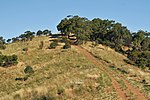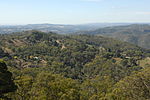Kangaroo Creek Reservoir
Adelaide stubsDams completed in 1969Dams in South AustraliaEmbankment damsGeography of Adelaide ... and 3 more
Reservoirs in South AustraliaRock-filled damsUse Australian English from September 2014

Kangaroo Creek Reservoir is a 19,160 megalitres (677×10^6 cu ft) artificial water storage reservoir in the Adelaide Hills, South Australia. It was built from 1966 to 1969, by damming the River Torrens west of Cudlee Creek. The stored water is used to maintain the Hope Valley Reservoir's level via discharge through the Torrens. Water is held back by a 131 metres (430 ft) long, 65 m (213 ft) high concrete clad, rock filled dam wall.It is named after Kangaroo Creek, a tributary of the Torrens with a 18 km2 (7 sq mi) drainage basin, which enters the reservoir on its southern side.
Excerpt from the Wikipedia article Kangaroo Creek Reservoir (License: CC BY-SA 3.0, Authors, Images).Kangaroo Creek Reservoir
Old Gorge Road, Adelaide Hills Council
Geographical coordinates (GPS) Address Nearby Places Show on map
Geographical coordinates (GPS)
| Latitude | Longitude |
|---|---|
| N -34.866666666667 ° | E 138.76666666667 ° |
Address
Old Gorge Road
Old Gorge Road
5132 Adelaide Hills Council
South Australia, Australia
Open on Google Maps







